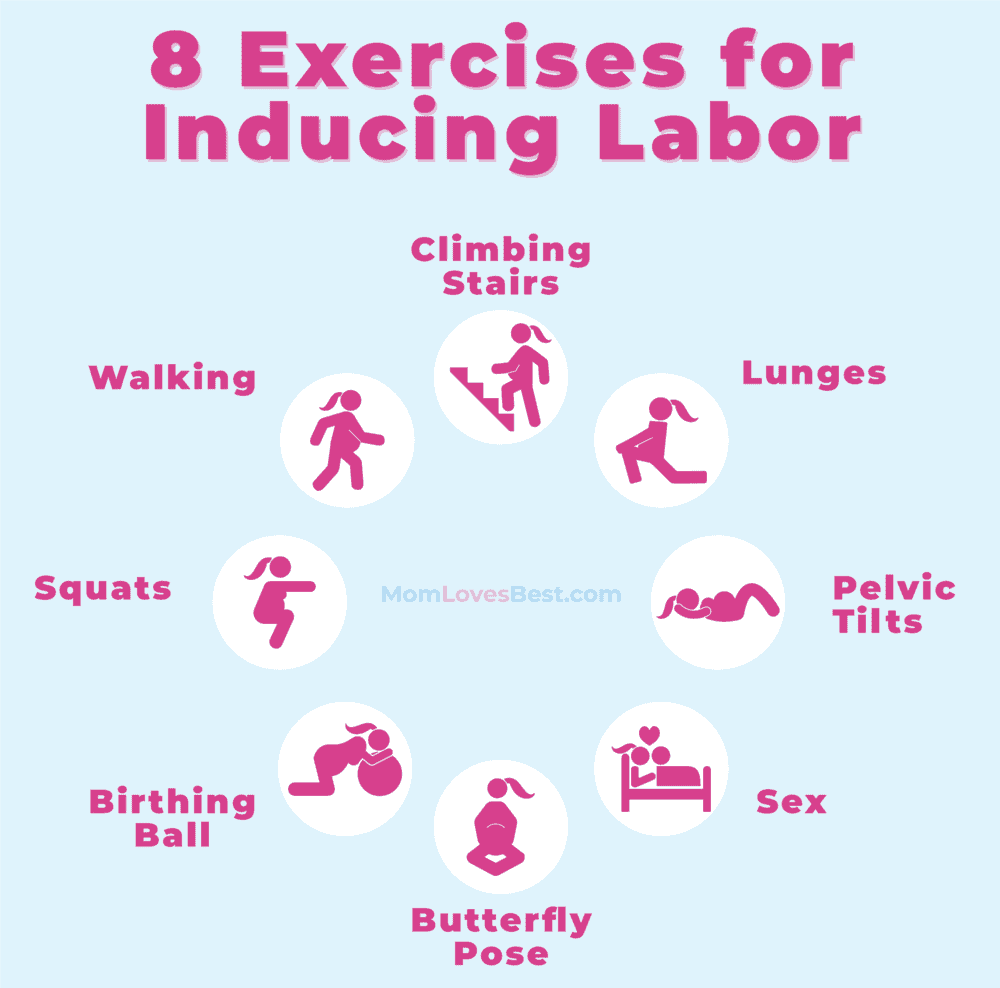Are you past your due date and hoping to naturally stimulate labor so you won’t have to be induced with medication?
As you anxiously await your baby’s birth, you may wonder if you should try to induce labor or if it’s best to let your baby come on their own. While most babies come out when they are ready, some need a little extra encouragement to make the move.
In this post, we’ll discuss when it’s okay to try to induce labor, who should and shouldn’t use exercise to stimulate labor, and we’ll teach you eight effective exercises to help induce labor naturally.
Key Takeaways
- It is best to speak with an obstetrician or midwife before trying to induce labor, and the optimal time to encourage labor to start is between 39 to 41 weeks gestation.
- Regular exercise is safe for the majority of pregnant women, but those with certain conditions should speak with their care provider first.
- Walking, climbing stairs, and doing squats are three low-impact exercises that can help encourage labor naturally.
When Is it Okay to Try to Induce Labor?
It’s always best to speak with your obstetrician or midwife before trying to induce labor. But generally speaking, the optimal time to encourage labor to start is between 39 to 41 weeks gestation. Babies born during this period are considered full-term and have the best possible health outcomes (1).
If you try to induce labor too early, your baby could have issues with breastfeeding, jaundice, or even breathing problems. Babies who go to 39 to 40 weeks gestation have also been shown to have better brain development than those born before this period.
However, if you have not given birth by 42 weeks, your care provider will monitor you more closely and discuss possible medical interventions. There are some risks that begin to increase at this point, such as harder labor, placenta deterioration, fetal distress, decreased amount of amniotic fluid, and in rare cases, stillbirth (2).
Most care providers and the ACOG (American College of Obstetricians and Gynecology) recommend at least offering induction and doing a biophysical profile and nonstress test at 41 weeks (3).
Editor's Note:
Caitlin Goodwin, MSN, RN, CNMThere are also some cases where you might be facing an early medical induction due to other risk factors, but you may want to try some natural methods first.
Remember
Who Shouldn’t Use Exercise to Induce Labor?
Regular exercise is safe for the majority of pregnant women. However, there are some instances where exercises may not be the safest option for inducing labor.
If you have any of the following conditions, it’s best to speak with your care provider before performing any exercise.
- Prescribed bed rest.
- Pre-eclampsia.
- Severely high or low amniotic fluid.
- Placenta previa or any other condition involving the placenta.
- History of premature labor.
- Gestational hypertension.
- Short cervix.
8 Activities to Naturally Induce Labor
If you’re at or past your due date, you may want to try some of these eight activities to help get things moving and avoid a medical induction.
1. Walking
A simple walk keeps your body healthy and can even help jump-start labor. Walking may also help speed up slow labors. This low-impact exercise promotes uterine contractions, particularly with women who haven’t been as active during their pregnancy.
By taking a brisk walk around the neighborhood, you can help your cervix dilate and your baby drop further into your pelvis. If nothing else, it’s a pleasant distraction that will help relax your body and your mind.
So if you’re impatiently awaiting your baby’s arrival, try hitting the trail, strolling the mall, or simply walking around your house.
2. Climbing Stairs
Walking up the stairs will naturally angle your body at about 40 to 45 degrees, which encourages your baby to move lower into your pelvis.
Skipping a step opens the pelvis more, allowing your baby to descend even further, putting gentle pressure on your cervix and encouraging it to thin and dilate. This is the exact cycle of events required for labor to occur.
Find a flight of stairs and carefully head up and down them a few times.
Use Your Head As Well As Your Legs
3. Squats
Squats are a great exercise to routinely do throughout your entire pregnancy, as they help you prepare for labor and maintain your strength in your legs, hips, and pelvic floor.
Squats allow gravity to help open your pelvis, giving your baby more room to descend further into the birth canal, which helps kick-start labor. They have also been shown to reduce labor times.
So, whenever you need to bend over to pick something up, squat instead!
To do squats properly, make sure you are standing straight up with your feet shoulder-width apart. As you gently squat, keep your back straight, and ensure your knees aren’t protruding.
Try to hold this position for 20 to 30 seconds before using your legs to lift yourself back up to the standing position.
4. Lunges
Lunges can help prepare your body for the natural birth you’ve always dreamed of. Doing lunges daily will help warm up your hips and open your pelvis, allowing more room for your baby to rotate and descend.
To do a lunge, stand with your feet together. Take a giant step forward and drop your back knee to the ground. Your front knee should be in line with your front ankle, your back knee dropped below your back ankle, and your spine straight.
Try to hold this position for 5 to 10 seconds or until you feel a burning sensation and then push back up.
This may be a difficult exercise to perform toward the end of pregnancy, so don’t be afraid to ask your partner or your doula for some assistance.
5. Birthing Ball
Get off that couch, and sit on your birthing ball! Birthing balls, also known as exercise balls, are an excellent tool to help prepare your body for birth and naturally induce labor.
By sitting on your birthing ball with wide legs, you will help increase blood flow to your uterus, placenta, and baby. You’ll also open your pelvic outlet, encourage your baby to descend, and help get them into the correct position.
Birthing balls also help create easier and faster births and encourage better postpartum recoveries.
There are many useful exercises you can do with your birthing ball, but some of the best ones for stimulating labor include bouncing, leaning, circular hip rotations, and rocking back and forth. Circular hip rotations help open your pelvis to your babe’s head, tuck their little chin, and move them into the perfect position.
6. Pelvic Tilts
Pelvic tilts are one of the simplest and most useful exercises to induce labor naturally. They keep the pelvic joints loose and are an excellent way to help get your baby into the optimal birthing position.
There are several different ways to do pelvic tilts, but the safest way during pregnancy is to do them on your hands and knees. These are also commonly known as the cat-cow stretch in yoga practices.
You will lift your lower back toward the ceiling, hold it for five to ten seconds, then straighten it. You can do about 30 to 40 of these per day (4).
7. Butterfly Stretch
Remember that butterfly stretch you did during your gym class warm-ups? This classic stretching position increases flexibility in your pelvic joints, which can aid in inducing labor naturally.
To do this stretch, sit up straight on the floor — it may be helpful to sit with your back against a wall. Place the soles of your feet together, and gently press your knees toward the ground with your hands or elbows.
Remain in this position for 15 to 30 seconds and repeat 5 to 10 times. This will stretch the muscles in your back, hips, pelvis, and inner thighs, preparing your body for a successful labor and delivery.
8. Sex
Having sex is what got you into this situation, and it may help get you out of it as well!
Doing the deed burns calories and is also a great way to help stimulate labor. Orgasm prompts the release of oxytocin, which causes the uterus to contract.
It also creates the release of prostaglandins, which are natural hormone-like substances that soften the cervix and potentially cause dilation. Prostaglandins are also present in semen (5).
You should avoid this method if your water has already broken, as it will increase your risk of infection.
Getting Baby into the “Sweet Spot”
When your baby is overdue, you may be racking your brain to try to figure out what else you can do. Some believe that babies don’t come until they are engaged in your pelvis and positioned properly.
By getting chiropractic care throughout pregnancy, you improve your chances of getting your baby into the pelvis before labor. Many birth workers encourage you to use prenatal exercises to help your baby into a suitable position for birth. Some of these exercises include:
- Hands and knees position: Alternating between the yoga poses cat and cow, where you arch your spine and sway your back.
- Inversions: Turning upside down in forward-leaning inversion may help reposition baby. If you are going to try this, be careful — pregnant women can be off balance! Place your knees on an elevated surface, like a couch, and your arms on the ground.
- Belly lift: Lift your belly, and flatten your back. This works particularly well during contractions.
- Rebozo: The Rebozo is a long swath of handwoven fabric from Mexican culture that is six feet by two feet. You can use it in pregnancy and labor to relax the muscles around the pelvis to give the baby space to turn. Some women choose to tie it tightly around the hips to support the belly.
- Hip circles and figure eights: Moving your hips in large circles and figure eights can help finagle your baby into a better place.
FAQs
Get Moving
If you’re past due and trying to encourage labor to begin, you need to start moving.
But remember, while exercise can be quite useful for opening the pelvis and getting your baby into a good position, try not to overdo it, as you’ll need plenty of energy when you’re in labor.
Did you try to induce your labor naturally? What methods worked for you?













